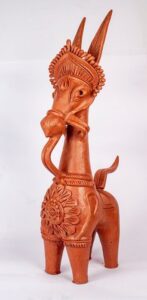How Terracotta Bankura Horses are made

Introduction
Famous Bankura Horse is a traditional terracotta horse, produced in Panchmura village of Bankura district in the eastern Indian state of West Bengal. What makes this Terracotta stand out is its elegant stance and unique abstraction of basic values. For centuries terracotta horses, elephants and other figures are being used for village rituals, besides that, now it has taken a defining space in the drawing rooms of art lovers around the world as a symbol of Indian folk art.
Bengal is the only State that still preserves century old traditional Art Forms in their originality by creating hundreds of Art and Craft Centres in the deep interior villages where the artisans live and practice their art, a knowledge that was passed on generation by generation. State Govt organizes Handicraft Melas throughout the year in different parts to facilitate buyer interaction.
Srejonee has proudly joined this crusade to preserve Indian heritage from going to extinction under the tremendous pressure of modern lifestyle.
Geographical Indication
The Bankura Horse is a GI Tagged product and it is also the official logo of All India Handicrafts. Bankura horse is registered under the Geographical Indications of West Bengal, named Bankura Panchmura Terracotta Craft on 28 March 2018.
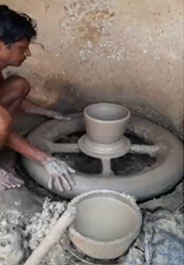
History
Terracotta or clay craft has been the symbol of man’s first attempt at craftsmanship, just as the potter’s wheel was the first machine invented to use the power of motion for a productive purpose. For many years, civilizations have been dated and assessed by the degree of skill and beauty displayed by the earthenware found in excavations. Because of its universal appeal pottery has often been termed as the lyric of handicrafts. However, its association with religious rituals has imbibed it with deeper significance. In India, terracotta traditions are found from the earliest times.
Village Ritual
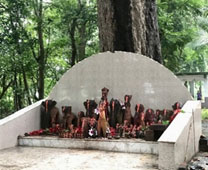
The outskirts of many an Indian village are seen to have a pipal tree with terracotta animal figures lying underneath it. They are symbols of fulfilment of aspirations of village folk. In order to cater to the commercial requirements of the modern global market, the village potter is often combining the traditional rural abstractions with refined urban tastes to show pieces of terracotta art.
Where and how it is made
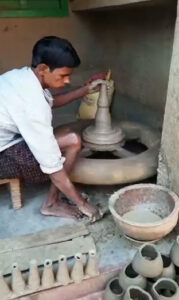
The principal centres where the terracotta horses and elephants are produced are Panchmura, Rajagram, Sonamukhi and Hamirpur. Each place has its local style. The Panchmura-style of pottery is considered the best and the finest of all the four types.
Different parts of the hollow terracotta horses are turned out in separate parts, on the potter’s wheel. The four legs, the full neck in two parts and the face (seven pieces in all) are turned out separately on the wheel and then joined together. Additional clay is used for making up defects that may remain in the shape of the body. The leaf-like ears and the tails are done in moulds and are later inserted in grooves left on the body. The clay figures are then allowed to dry in the sun. After a little drying in the sun, holes are made on appropriate parts of the body in order that the inner and the outer surfaces of the body are equally dried. Cracks may develop in the body because of unequal drying of the inner and the outer portions. The dehydration is slowly done in the normal temperature of a closed room for
about six or seven days. Then they are brought out of the room and heated in the sun. Finally, they are burnt in a crude oven for five hours under the controlled heat by burning wood and dry leaves. Fully burnt clay takes the colour of brick red or black depending on the temperature that in meant for it.
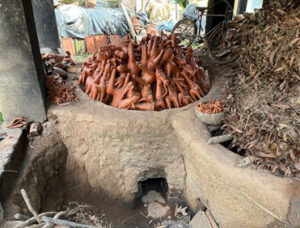
The terracotta horses of Bankura are turned out in two different colours. The normal terracotta red color is obtained by letting out the smoke through the vents of the kiln after
firing, and the black colour is obtained by sealing the vents and not letting out the smoke.
In the Rarh region where Dharmathakur is worshipped there is no end to the symbolic use of terracotta and wooden horses. Symbolic sacrifice of horses for fulfilment of wishes is common for many village gods and goddesses, but an assembly of terracotta horses of various shapes and sizes representing sacrifice on wish fulfilment is perhaps peculiar to Dharmathakur.

Terracotta horses and elephants in Bankura have been the creation of potters. Over the centuries they have moved away from a realistic presentation to a representational presentation. Potter-artists of different regions focused on different parts of the animal body in such a manner that representation of the same became
more important than representation of the entire body of the animal.
MANASA CHALI
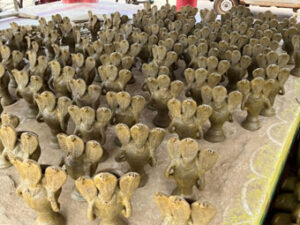
Manasa chali, or Manasa bari, is a type of idol of Debi Manasa made of Terracotta in Panchmura, West Bengal, India. It typically features a small figure or a group of three figures in the middle with rows of snake hoods fanning out in a half moon shape. Chali or bari is Bengali for ‘the shade of something’. Chali is referred to here as ‘the shade of idol’ or ‘the besh of idol’, like Chalchitra. These idols have two basic colours, reddish-yellow and black.
Manasa chali is registered under the Geographical Indications of West Bengal, named Bankura Panchmura Terracotta Craft on 28 March, 2018. Panchmura Manasa, the snake deity, is worshiped primarily for protection from snakebites. The story of Chand Saudagar (The Devotee of Shiva) is well-known throughout the Bankura district. Manasa Chali and the Manasa Ghat are worshiped in Panchmura.
Pottery in the Indian subcontinent has an ancient history and is one of the most tangible and iconic elements of Indian art. Evidence of pottery has been found in the early settlements of Lahuradewa and later the Indus Valley Civilisation. Today, it is a cultural art that is still practiced extensively in Indian subcontinent. Until recent times all Indian pottery has been earthenware, including terracotta.
The unfortunate part of the story is this ancient art is facing extinction against the modern lifestyle we adopted. Few decades back entire rural India used earthen utensil for cooking, storing food grains water oil and everything. Then came metal utensils in brass and copper, then more affordable aluminium, Iron, and now all invading Plastic. All these advances were made at the cost of the ancient Pottery which were scientific natural and eco-friendly.
Large section of potters left their traditional work and migrated into labour force for living. Few transformed into making articles for home décor and utility like lams etc.
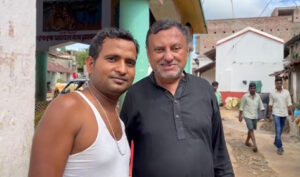
Panchmura village. October 2022
Srejonee has dedicated itself in bringing back the old traditional artform in developing Cutlery and Utensils which suits modern lifestyle and bring back the healthy eco-friendly environment to all.
Our home décor and Dinner set, Tea Set, Coffee Mugs, water bottle, Jug and Glasses, wine glass are well accepted in urban society of India and Abroad.
Unless we devote ourselves for this cause and provide the village potter a opportunity to have a dignified living, our future generations will never get a chance see a fine Earthen wear except in the museums.

